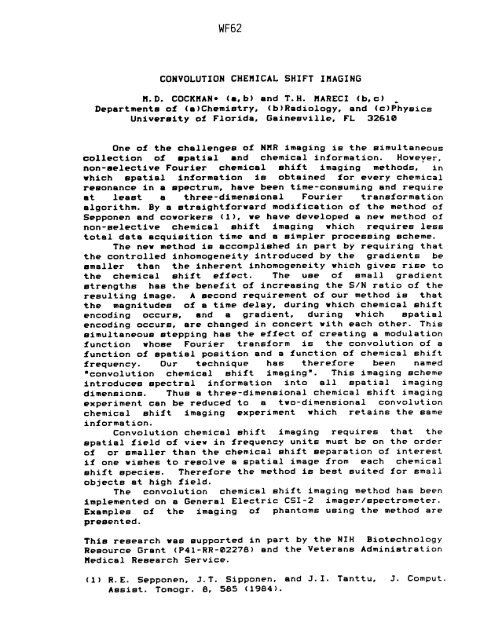th - 1987 - 51st ENC Conference
th - 1987 - 51st ENC Conference
th - 1987 - 51st ENC Conference
Create successful ePaper yourself
Turn your PDF publications into a flip-book with our unique Google optimized e-Paper software.
WF62<br />
CONVOLUTION CHEMICAL SHIFT IMAGING<br />
M.D. COCKMAN- (a,b) and T.H. MARECI (b,c)<br />
Departments of (a)Chemistry, (b)Radiology, and (c)Physics<br />
University of Florida, Gainesville, FL 32610<br />
One of <strong>th</strong>e challenges of NMR imaging is <strong>th</strong>e simultaneous<br />
collection of spatial and chemical information. However,<br />
non-selectlve Fourier chemical shift imaging me<strong>th</strong>ods, in<br />
which spatial information is obtained for every chemical<br />
resonance in a spectrum, hmve been time-consuming and require<br />
at least a <strong>th</strong>ree-dlmensional Fourier transformation<br />
algori<strong>th</strong>m. By a straightforward modification of <strong>th</strong>e me<strong>th</strong>od of<br />
Sepponen and coworkers (1), we have developed a new me<strong>th</strong>od of<br />
non-selectlve chemical shift imaging which requires less<br />
total data acquisition time and a simpler processing scheme.<br />
The new me<strong>th</strong>od is accomplished in part by requiring <strong>th</strong>at<br />
<strong>th</strong>e controlled inhomogeneity introduced by <strong>th</strong>e gradients be<br />
smaller <strong>th</strong>an <strong>th</strong>e inherent inhomogeneity which gives rise to<br />
<strong>th</strong>e chemical shift effect. The use of small gradient<br />
streng<strong>th</strong>s has <strong>th</strong>e benefit of increasing <strong>th</strong>e S/N ratio of <strong>th</strong>e<br />
resulting image. A second requirement of our me<strong>th</strong>od is <strong>th</strong>at<br />
<strong>th</strong>e magnitudes of a time delay, during which chemical shift<br />
encoding occurs, and a gradient, during which spatial<br />
encoding occurs, are changed in concert wi<strong>th</strong> each o<strong>th</strong>er. This<br />
simultaneous stepping has <strong>th</strong>e effect of creating a modulation<br />
function whose Fourier transform is <strong>th</strong>e convolution of a<br />
function of spatial position and a function of chemical shift<br />
frequency. Our technique has <strong>th</strong>erefore been named<br />
aconvolution chemical shift imaging'. This imaging scheme<br />
introduces spectral information into all spatial imaging<br />
dimensions. Thus a <strong>th</strong>ree-dimensional chemical shift imaging<br />
experiment can be reduced to a two-dimensional convolution<br />
chemical shift imaging experiment which retains <strong>th</strong>e same<br />
information.<br />
Convolution chemical shift imaging requires <strong>th</strong>at <strong>th</strong>e<br />
spatial field of view in frequency units must be on <strong>th</strong>e order<br />
of or smaller <strong>th</strong>an <strong>th</strong>e chemical shift separation of interest<br />
if one wishes to resolve a spatial image from each chemical<br />
shift species. Therefore <strong>th</strong>e me<strong>th</strong>od is best suited for small<br />
objects at high field.<br />
The convolution chemical shift imaging me<strong>th</strong>od has been<br />
implemented on a General Electric CSI-2 imager/spectrometer.<br />
Examples of <strong>th</strong>e imaging of phantoms using <strong>th</strong>e me<strong>th</strong>od are<br />
presented.<br />
This research was supported in part by <strong>th</strong>e NIH Biotechnology<br />
Resource Grant (P41-RR-02278) and <strong>th</strong>e Veterans Administration<br />
Medical Research Service.<br />
(1) R.E. Sepponen, J.T. Sipponen, and J.I. Tanttu,<br />
Assist. Tomogr. 8, 585 (1984).<br />
J. Comput.













